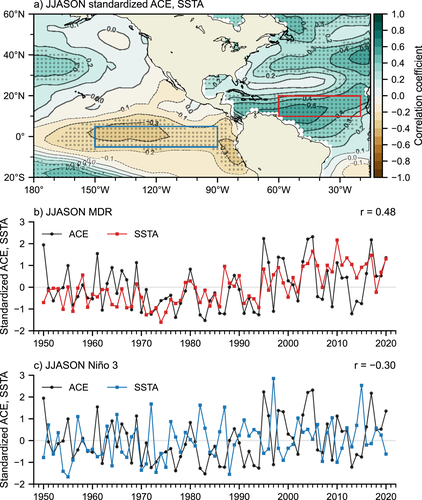NGI Researchers models suggest "Seasonality of Interbasin SST Contributions to Atlantic Tropical Cyclone Activity"
March 31, 2022

Recent studies have demonstrated that the difference in sea surface temperature anomalies (SSTAs) between the tropical Atlantic main development region (MDR) and the tropical Pacific (Nino 3) modulates Atlantic tropical cyclone activity. This study further explores the seasonality of Pacific and Atlantic contributions to Atlantic hurricane activity. Our analysis shows that while MDR and Nino 3 SSTAs are equally important for late-season (September–November) activity, early-season (June-August) activity is largely modulated by MDR SSTAs. This reflects the increased (reduced) variance of MDR (Nino 3) SSTAs in the early-season due to their phase locking to the seasonal cycle. Further analysis yields skillful forecasts using an MDR-Nino 3 interbasin index derived from hindcasts of the North American Multi-Model Ensemble with May initial conditions. However, the prediction skill for MDR SSTAs is lower than that of Nino 3 SSTAs, suggesting that increasing the prediction skill for MDR SSTAs is key to improving seasonal outlooks.
The difference in sea surface temperatures (SST) between the tropical Atlantic and the tropical Pacific changes atmospheric circulation patterns that affect Atlantic hurricane activity during the June–November Atlantic hurricane season. This study finds that tropical Atlantic SST have a stronger influence on hurricane activity in the early-season, but tropical Pacific and tropical Atlantic SST have equal influence in the late-season. This is because the seasonal variability of tropical Atlantic SST increases in the early-season, while the seasonal variability of tropical Pacific SST increases in the late-season, known as a seasonal phase locking mechanism. A statistical model of the differences in Atlantic and Pacific SST finds skillful forecasts of above-average hurricane activity throughout the hurricane season, with the greatest overall skill in the late-season.
Robert West,
Hosmay Lopez,
Sang-Ki Lee,
Andrew E. Mercer,
Dongmin Kim,
Gregory R. Foltz,
Karthik Balaguru
Link to document here: AGU or Academic Access Required
